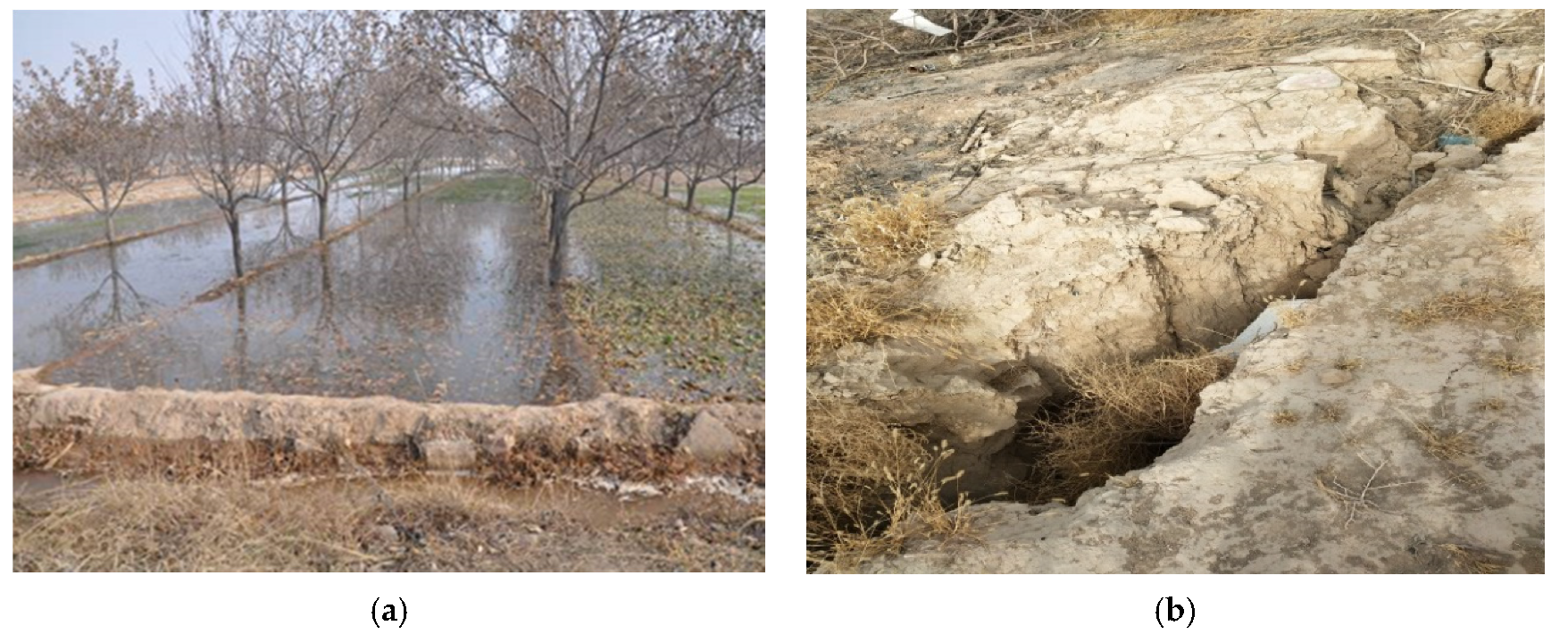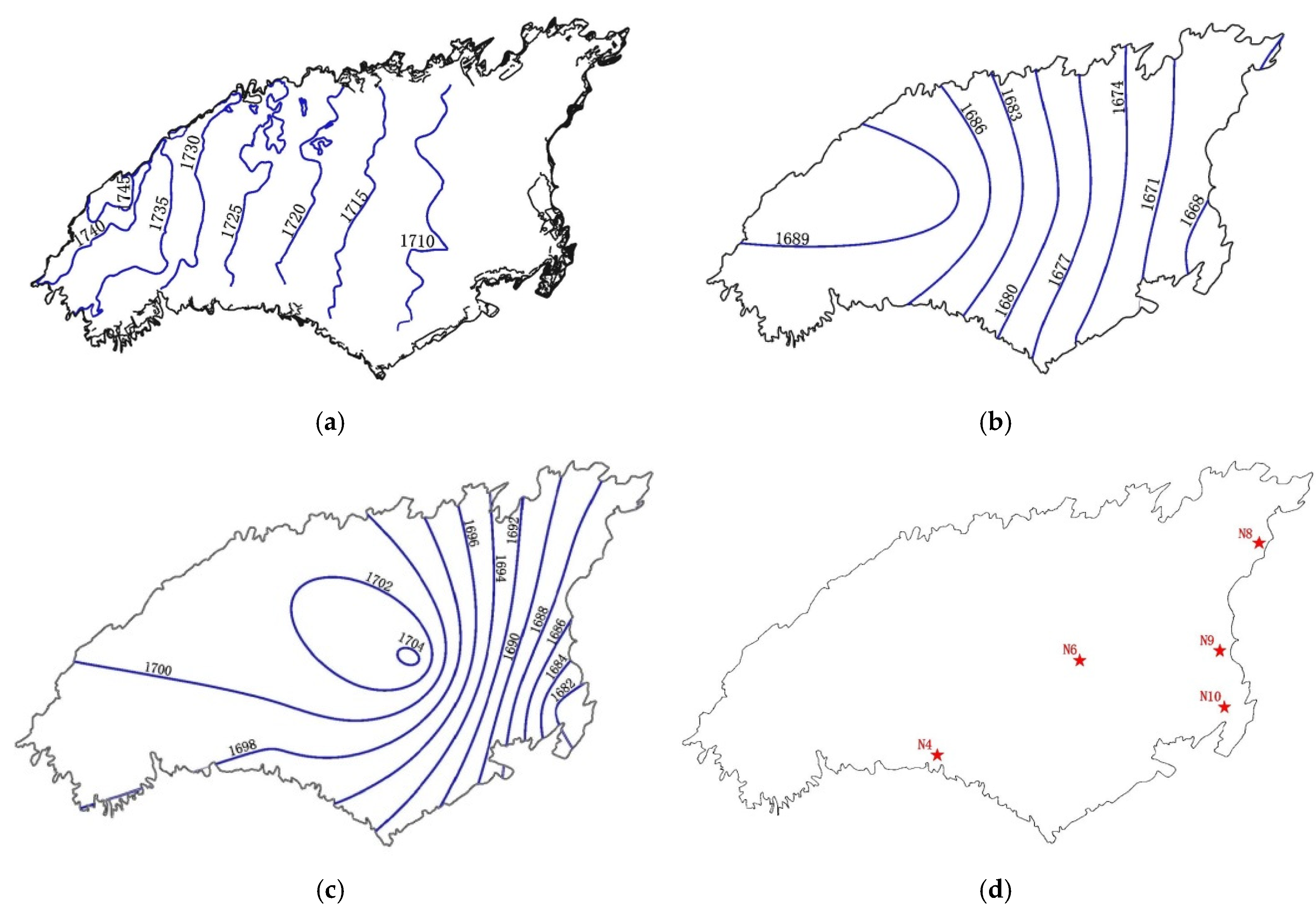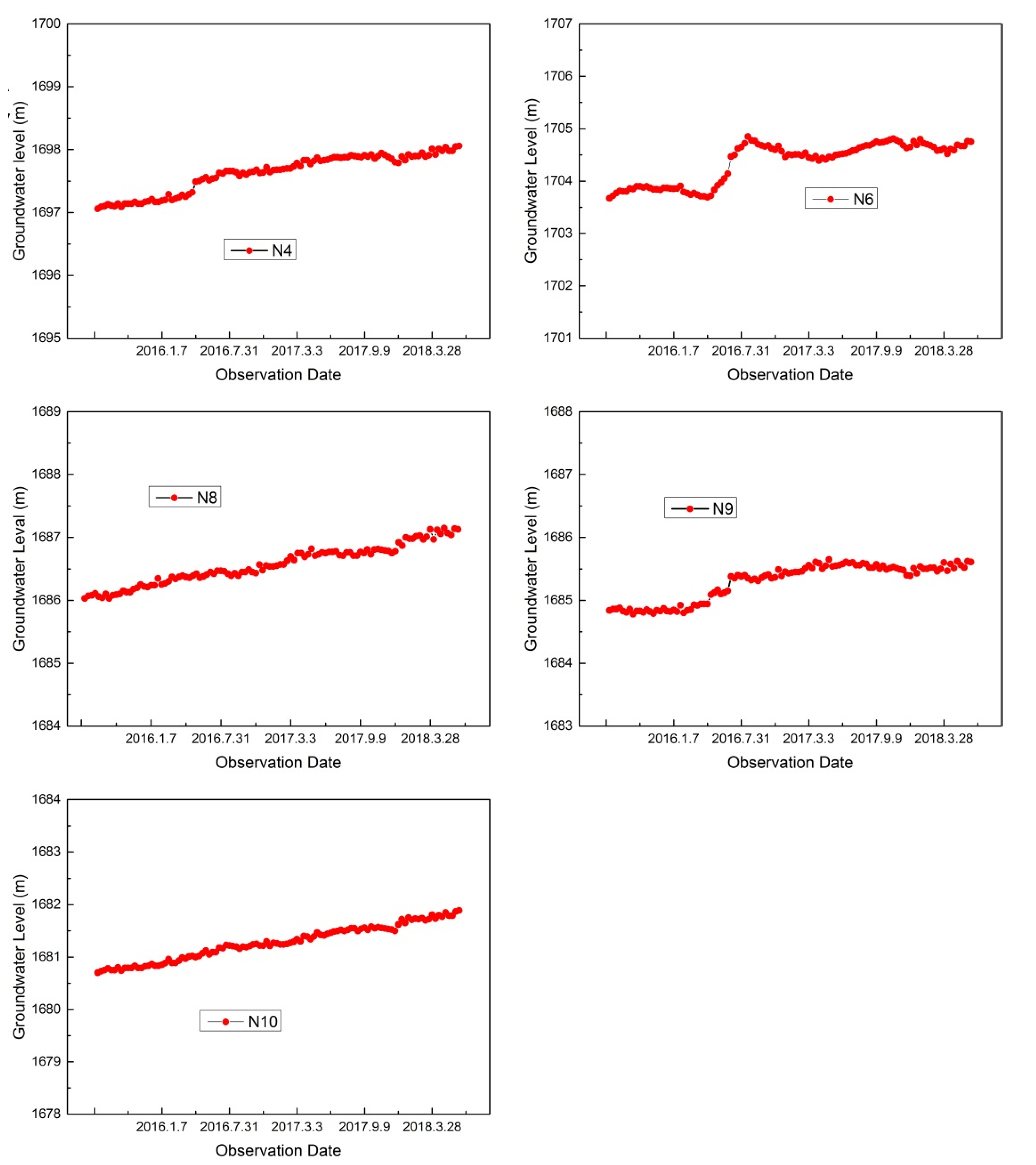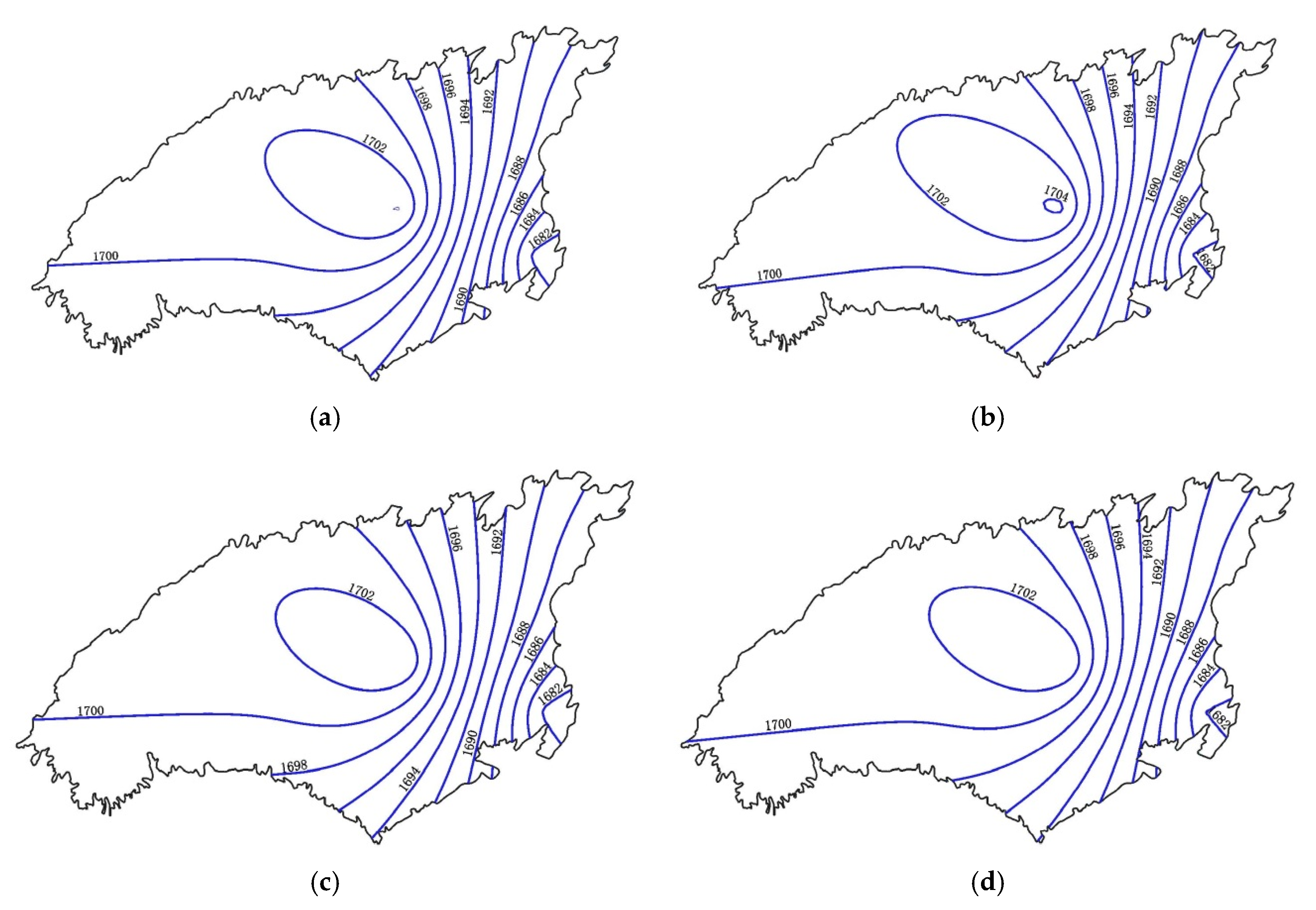Groundwater Response of Loess Tableland in Northwest China under Irrigation Conditions
Abstract
1. Introduction
- Taking Heitai, Gansu Province, as the research area, an unsaturated-saturated coupling flow model was established using the HYDRUS-MODFLOW software combined with rainfall, irrigation, and evaporation data;
- Combining groundwater level data monitored in the field with the Bayesian-MCMC random parameter inversion method, the optimization model is obtained by parameter calibration and model verification;
- Using the optimized model to predict the change of the trend of the groundwater flow field under different irrigation conditions and exploring effective measures to slow the rise of the groundwater level.
2. Materials and Methods
2.1. Basic Theory of Numerical Simulation
2.1.1. Unsaturated Transport Control Equation
2.1.2. Basic Theory of the HYDRUS-MODFLOW Model
2.1.3. Bayesian-MCMC Parameter Inversion Method
2.2. Geological Environment Conditions of Heitai, Gansu Province
2.2.1. Topographic Features
2.2.2. Stratigraphic Structure and Aquifer Characteristics
2.2.3. Hydrometeorology and Agricultural Irrigation
2.3. Basic Model Information
2.3.1. Generalization of the Boundary Conditions of the Calculation Model
2.3.2. Time Division of the Model
2.3.3. Spatial Division of the Model
3. Results and Discussion
3.1. Dynamic Change of the Groundwater Level
3.2. Inversion Results of the Model Parameters
3.3. Simulation Results of the Groundwater Level and Model Verification
3.3.1. Groundwater Level Simulation Results
3.3.2. Model Validation
3.4. Prediction of the Groundwater Level Change Trend
4. Conclusions
- On the basis of the coupling principle and operation mechanism of the HYDRUS-MODFLOW coupling model, the model is applied to simulate the groundwater level of Heitai in Gansu Province. The simulation results show that the HYDRUS-MODFLOW model has a good simulation effect on the water exchange process between saturated and unsaturated zones at the regional scale.
- To further improve the practicability and simulation accuracy of the HYDRUS-MODFLOW model, it is combined with the Bayesian-MCMC parameter inversion method. The parameters in the model are inverted and verified using the measured groundwater level data in the field water level holes. The results show that the simulation values of the coupling model fit well with the measured values, which indicates that the model can better simulate the transformation relationship among surface water, soil water, and groundwater at the regional scale in Heitai.
- The development trend of the groundwater level of the Heitai groundwater system in Gansu Province in the next 3 years under different irrigation intensities is predicted using the optimized model. The prediction results show that the groundwater level is seriously affected by the irrigation intensity. The groundwater level increases with the increase of the irrigation intensity and decreases with the decrease of the irrigation intensity. A reasonable reduction of the irrigation intensity can slow the rising speed of the groundwater level.
- Measures to reduce the groundwater level in Heitai are recommended, such as reasonable reduction of the irrigation amount by changing the irrigation mode; adjustment of the crop structure and planting area to reduce uneven irrigation as much as possible; and direct discharge of groundwater by adopting the drainage test scheme.
Author Contributions
Funding
Acknowledgments
Conflicts of Interest
References
- Gu, T.; Wang, J.; Wang, C.; Bi, Y.; Guo, Q.; Liu, Y. Experimental study of the shear strength of soil from the Heifangtai Platform of the Loess Plateau of China. J. Soils Sediments 2019, 19, 3463–3475. [Google Scholar] [CrossRef]
- Meng, Q.; Xu, Q.; Wang, B.; Li, W.; Peng, Y.; Peng, D.; Qi, X.; Zhou, D. Monitoring the regional deformation of loess landslides on the Heifangtai terrace using the Sentinel-1 time series interferometry technique. Nat. Hazards 2019, 98, 485–505. [Google Scholar] [CrossRef]
- Liu, X.; Zhao, C.; Zhang, Q.; Yang, C.; Zhu, W. Heifangtai loess landslide type and failure mode analysis with ascending and descending Spot-mode TerraSAR-X datasets. Landslides 2020, 17, 205–215. [Google Scholar] [CrossRef]
- Xu, L.; Dai, F.C.; Gong, Q.M.; Tham, L.G.; Min, H. Irrigation-induced loess flow failure in Heifangtai Platform, North-West China. Environ. Earth Sci. 2012, 66, 1707–1713. [Google Scholar] [CrossRef]
- Leng, Y.; Peng, J.; Wang, Q.; Meng, Z.; Huang, W. A fluidized landslide occurred in the Loess Plateau: A study on loess landslide in South Jingyang tableland. Eng. Geol. 2018, 236, 129–136. [Google Scholar] [CrossRef]
- Cui, S.; Pei, X.; Wu, H.; Huang, R. Centrifuge model test of an irrigation-induced loess landslide in the Heifangtai loess platform, Northwest China. J. Mt. Sci. 2018, 15, 130–143. [Google Scholar] [CrossRef]
- Arnold, J.G.; Allen, P.M.; Bernhardt, G. A comprehensive surface-groundwater flow model. J. Hydrol. 1993, 142, 47–69. [Google Scholar] [CrossRef]
- Sophocleous, M. Interactions between groundwater and surface water: The state of the science. Hydrogeol. J. 2002, 10, 52–67. [Google Scholar] [CrossRef]
- Li, W.; He, J. Analysis of Relation and Variation Characteristics Between Soil Water and Groundwater in Planting Conditions. Earth Sci. 2015, 4, 235–240. [Google Scholar] [CrossRef]
- Chen, X.; Hu, Q. Groundwater influences on soil moisture and surface evaporation. J. Hydrol. 2004, 297, 285–300. [Google Scholar] [CrossRef]
- Xie, W.; Yang, J. Assessment of Soil Water Content in Field with Antecedent Precipitation Index and Groundwater Depth in the Yangtze River Estuary. J. Integr. Agric. 2013, 12, 711–722. [Google Scholar] [CrossRef]
- Ramos, T.B.; Simionesei, L.; Jauch, E.; Neves, R. Modelling soil water and maize growth dynamics influenced by shallow groundwater conditions in the Sorraia Valley region, Portugal. Agric. Water Manag. 2017, 185, 27–42. [Google Scholar] [CrossRef]
- Chen, Z.; Govindaraju, R.S.; Kavvas, M.L. Spatial averaging of unsaturated flow equations under infiltration conditions over areally heterogeneous fields: 1. Development of models. Water Resour. Res. 1994, 30, 523–533. [Google Scholar] [CrossRef]
- Chen, Z.; Govindaraju, R.S.; Kavvas, M.L. Spatial averaging of unsaturated flow equations under infiltration conditions over areally heterogeneous fields: 2. Numerical simulations. Water Resour. Res. 1994, 30, 535–548. [Google Scholar] [CrossRef]
- Sherlock, M.D.; McDonnell, J.J.; Curry, D.S.; Zumbuhl, A.T. Physical controls on septic leachate movement in the vadose zone at the hillslope scale, Putnam County, New York, USA. Hydrol. Process. 2002, 16, 2559–2575. [Google Scholar] [CrossRef]
- Sophocleous, M.A.; Koelliker, J.K.; Govindaraju, R.S.; Birdie, T.; Ramireddygari, S.R.; Perkins, S.P. Integrated numerical modeling for basin-wide water management: The case of the Rattlesnake Creek basin in south-central Kansas. J. Hydrol. 1999, 214, 179–196. [Google Scholar] [CrossRef]
- Semiromi, M.T.; Koch, M. Analysis of spatio-temporal variability of surface–groundwater interactions in the Gharehsoo river basin, Iran, using a coupled SWAT-MODFLOW model. Environ. Earth Sci. 2019, 78, 201. [Google Scholar] [CrossRef]
- Kim, N.W.; Chung, I.M.; Won, Y.S.; Arnold, J.G. Development and application of the integrated SWAT-MODFLOW model. J. Hydrol. 2008, 356, 1–16. [Google Scholar] [CrossRef]
- Facchi, A.; Ortuani, B.; Maggi, D.; Gandolfi, C. Coupled SVAT–groundwater model for water resources simulation in irrigated alluvial plains. Environ. Modell. Softw. 2004, 19, 1053–1063. [Google Scholar] [CrossRef]
- Kuznetsov, M.; Yakirevich, A.; Pachepsky, Y.A.; Weisbrod, N. Quasi 3D modeling of water flow in vadose zone and groundwater. J. Hydrol. 2012, 450, 140–149. [Google Scholar] [CrossRef]
- Bushira, K.M.; Hernandez, J.R.; Sheng, Z. Surface and groundwater flow modeling for calibrating steady state using MODFLOW in Colorado River Delta, Baja California, Mexico. Model. Earth Syst. Environ. 2017, 3, 815–824. [Google Scholar] [CrossRef]
- Lekula, M.; Lubczynski, M.W. Use of remote sensing and long-term in-situ time-series data in an integrated hydrological model of the Central Kalahari Basin, Southern Africa. Hydrogeol. J. 2019, 27, 1541–1562. [Google Scholar] [CrossRef]
- Cheng, Q.; Chen, X.; Chen, X.; Zhang, Z.; Ling, M. Water infiltration underneath single-ring permeameters and hydraulic conductivity determination. J. Hydrol. 2011, 398, 135–143. [Google Scholar] [CrossRef]
- Twarakavi, N.K.C.; Šimůnek, J.; Seo, S. Evaluating Interactions between Groundwater and Vadose Zone Using the HYDRUS-Based Flow Package for MODFLOW. Vadose Zone J. 2008, 7, 757–768. [Google Scholar] [CrossRef]
- Khu, S.T.; Werner, M.G.F. Reduction of Monte-Carlo Simulation Runs for Uncertainty Estimation in Hydrological Modelling. Hydrol. Earth Syst. Sci. 2003, 7, 680–692. [Google Scholar] [CrossRef]
- Arridge, S.R.; Kaipio, J.P.; Kolehmainen, V.; Schweiger, M.; Somersalo, E.; Tarvainen, T.; Vauhkonen, M. Approximation errors and model reduction with an application in optical diffusion tomography. Inverse Probl. 2006, 22, 175–195. [Google Scholar] [CrossRef]
- Ekblad, J.; Isacsson, U. Time-domain Reflectometry Measurements and Soil-water Characteristic Curves of Coarse Granular Materials Used in Road Pavements. Can. Geotech. J. 2007, 44, 858–872. [Google Scholar] [CrossRef]
- Vrugt, J.A.; Stauffer, P.H.; Wöhling, T.; Robinson, B.A.; Vesselinov, V.V. Inverse Modeling of Subsurface Flow and Transport Properties: A Review with New Developments. Vadose Zone J. 2008, 7, 843–864. [Google Scholar] [CrossRef]
- Godoy, V.A.; Zuquette, L.V.; Gómez-Hernández, J.J. Scale effect on hydraulic conductivity and solute transport: Small and large-scale laboratory experiments and field experiments. Eng. Geol. 2018, 243, 196–205. [Google Scholar] [CrossRef]
- Tarantino, A.; Ridley, A.M.; Toll, D.G. Field Measurement of Suction, Water Content, and Water Permeability. Geotech. Geol. Eng. 2008, 26, 751–782. [Google Scholar] [CrossRef]
- Zeng, L.; Shi, L.; Zhang, D.; Wu, L. A sparse grid based Bayesian method for contaminant source identification. Adv. Water Resour. 2012, 37, 1–9. [Google Scholar] [CrossRef]
- Man, J.; Liao, Q.; Zeng, L.; Wu, L. ANOVA-based transformed probabilistic collocation method for Bayesian data-worth analysis. Adv. Water Resour. 2017, 110, 203–214. [Google Scholar] [CrossRef]
- Levenberg, K. A Method for the Solution of Certain Non-linear Problems in Least Squares. Q. Appl. Math. 1944, 2, 164–168. [Google Scholar] [CrossRef]
- Maier, H.R.; Kapelan, Z.; Kasprzyk, J.; Kollat, J.; Matott, L.S.; Cunha, M.C.; Dandy, G.C.; Gibbs, M.S.; Keedwell, E.; Marchi, A.; et al. Evolutionary algorithms and other metaheuristics in water resources: Current status, research challenges and future directions. Environ. Modell. Softw. 2014, 62, 271–299. [Google Scholar] [CrossRef]
- Over, M.W.; Wollschläger, U.; Osorio-Murillo, C.A.; Rubin, Y. Bayesian inversion of Mualem-van Genuchten parameters in a multilayer soil profile: A data-driven, assumption-free likelihood function. Water Resour. Res. 2015, 51, 861–884. [Google Scholar] [CrossRef]
- Harbaugh, A.W.; Banta, E.R.; Hill, M.C.; McDonald, M.G. MODFLOW-2000, The US Geological Survey Modular Ground-Water Model—User Guide to Modularization Concepts and the Ground-Water Flow Process; Open-File Report 00-92; USGS: Reston, VA, USA, 2000.
- Vrugt, J.A. Markov chain Monte Carlo simulation using the DREAM software package: Theory, concepts, and MATLAB implementation. Environ. Modell. Softw. 2016, 75, 273–316. [Google Scholar] [CrossRef]










| Month | 7 | 8 | 9 | 10 | 11 | 12 | 1 | 2 | 3 | 4 | 5 | 6 |
|---|---|---|---|---|---|---|---|---|---|---|---|---|
| Irrigation | 5.81 | 5.45 | 2.63 | 0 | 3.00 | 0.16 | 0 | 0 | 0.55 | 3.37 | 4.35 | 7.50 |
| Rainfall | 1.79 | 2.26 | 1.27 | 0.55 | 0.07 | 0 | 0 | 0 | 0.26 | 0.53 | 1.19 | 1.37 |
| Evaporation | 6.97 | 6.19 | 4.27 | 3.23 | 2.17 | 1.26 | 1.29 | 1.39 | 4.06 | 6.67 | 7.13 | 7.10 |
| Month | 7 | 8 | 9 | 10 | ||||||||
|---|---|---|---|---|---|---|---|---|---|---|---|---|
| Number of stress period | No.1 | No.2 | No.3 | No.4 | No.5 | No.6 | No.7 | No.8 | No.9 | No.10 | No.11 | No.12 |
| Length of stress period (day) | 10 | 10 | 11 | 10 | 10 | 11 | 10 | 10 | 10 | 10 | 10 | 11 |
| Month | 11 | 12 | 1 | 2 | ||||||||
| Number of stress period | No.13 | No.14 | No.15 | No.16 | No.17 | No.18 | No.19 | No.20 | No.21 | No.22 | No.23 | No.24 |
| Length of stress period (day) | 10 | 10 | 10 | 10 | 10 | 11 | 10 | 10 | 11 | 10 | 10 | 8 |
| Month | 3 | 4 | 5 | 6 | ||||||||
| Number of stress period | No.25 | No.26 | No.27 | No.28 | No.29 | No.30 | No.31 | No.32 | No.33 | No.34 | No.35 | No.36 |
| Length of stress period (day) | 10 | 10 | 11 | 10 | 10 | 10 | 10 | 10 | 11 | 10 | 10 | 10 |
| Types | (1/m) | n | Kx (m/day) | Kz (m/day) | Sy | ||
|---|---|---|---|---|---|---|---|
| Initial values | 0.14 | 0.47 | 0.41 | 3.6 | 0.02 | 0.2 | 0.08 |
| Prior ranges | [0.08, 0.15] | [0.45, 0.5] | [0.4, 0.5] | [3.1, 4.5] | [0.015, 0.025] | [0.15, 0.25] | [0.07, 0.09] |
| Optimized values | 0.12 | 0.48 | 0.43 | 3.55 | 0.02 | 0.21 | 0.08 |
© 2020 by the authors. Licensee MDPI, Basel, Switzerland. This article is an open access article distributed under the terms and conditions of the Creative Commons Attribution (CC BY) license (http://creativecommons.org/licenses/by/4.0/).
Share and Cite
Dai, F.; Guo, Q. Groundwater Response of Loess Tableland in Northwest China under Irrigation Conditions. Water 2020, 12, 2546. https://doi.org/10.3390/w12092546
Dai F, Guo Q. Groundwater Response of Loess Tableland in Northwest China under Irrigation Conditions. Water. 2020; 12(9):2546. https://doi.org/10.3390/w12092546
Chicago/Turabian StyleDai, Fuchu, and Qinghua Guo. 2020. "Groundwater Response of Loess Tableland in Northwest China under Irrigation Conditions" Water 12, no. 9: 2546. https://doi.org/10.3390/w12092546
APA StyleDai, F., & Guo, Q. (2020). Groundwater Response of Loess Tableland in Northwest China under Irrigation Conditions. Water, 12(9), 2546. https://doi.org/10.3390/w12092546




